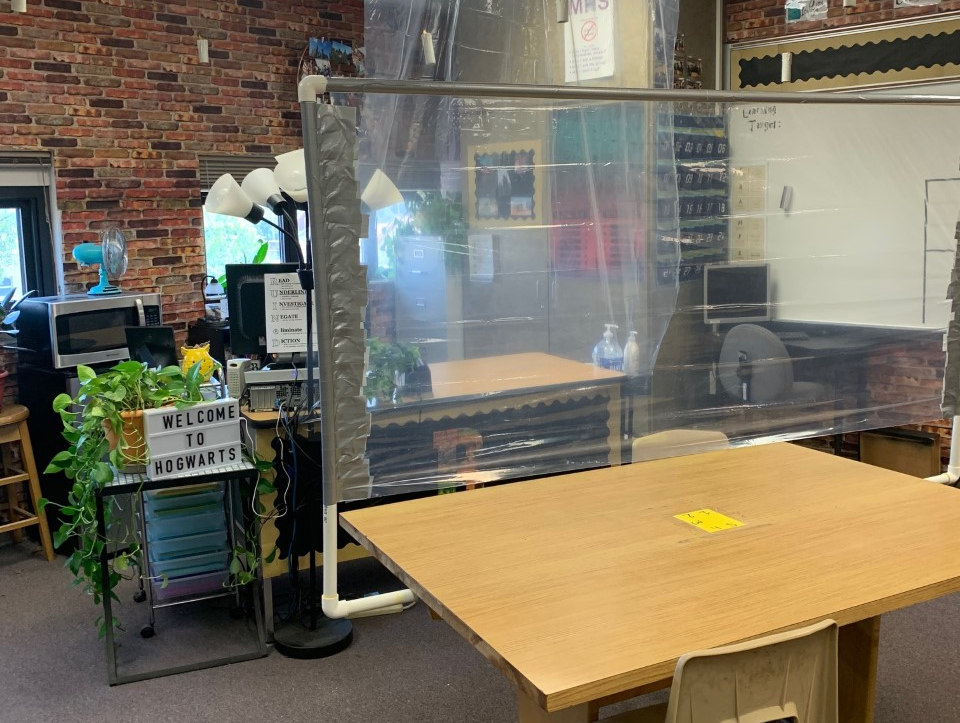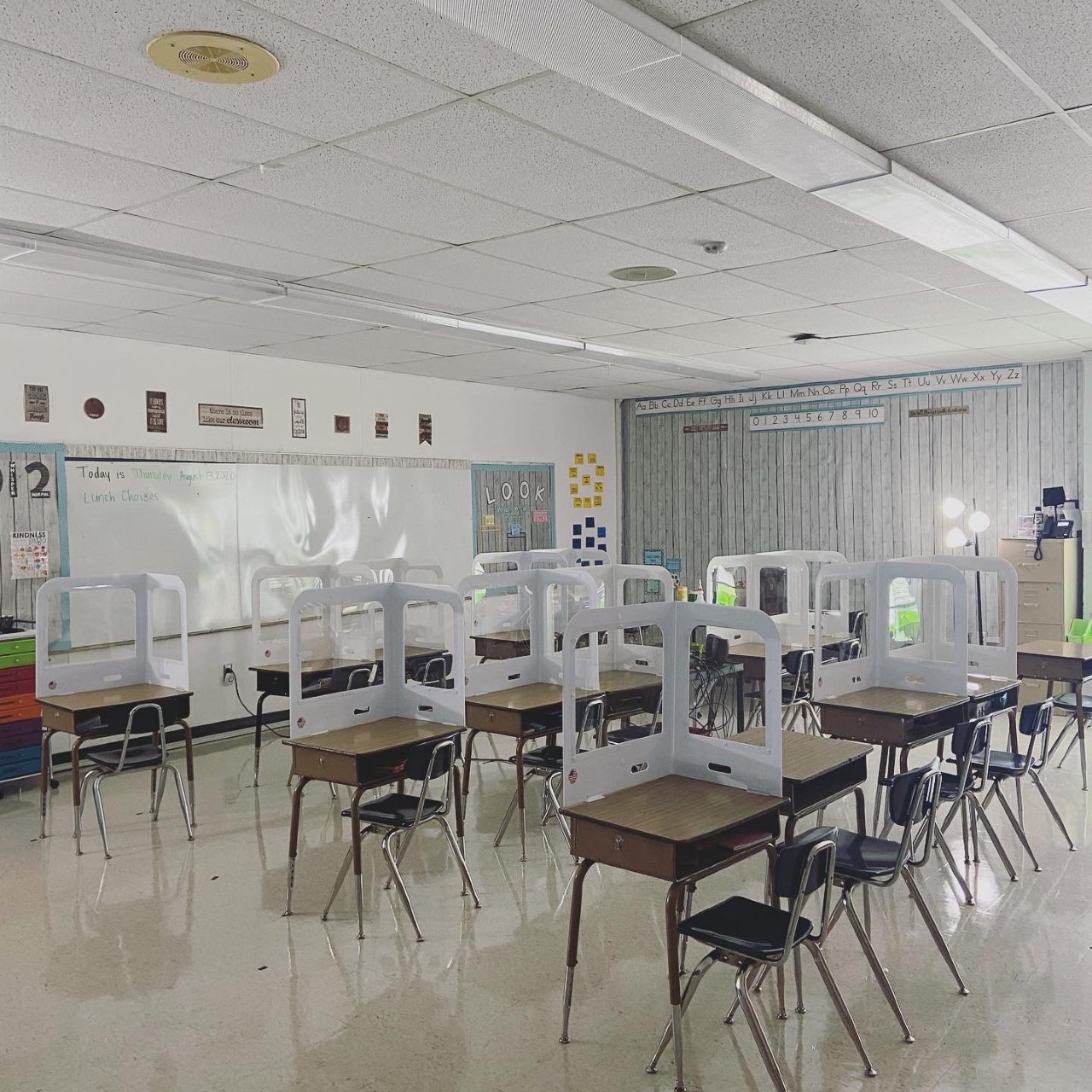
Teachers are heroes—there's no doubt about it. Between picking up the pieces to salvage a school year forced completely online last spring to risking their health (not to mention juggling families and crazy schedules on top of that) as some schools around the country begin to reopen for hybrid or fully in-person education, teachers have adjusted to the new reality of life amid a pandemic.
Now, as many kids are heading back to school in person for the first time since March, teachers have been busy prepping their classrooms to meet strict safety protocols. We've heard that things will look very different this year, but classrooms have seriously been stripped and rearranged, devoid of much of the warmth and personality of years past.
Here are just some of the ways teachers have reconfigured their classrooms over the past few weeks and educators are getting ready for the new school year—and a taste of what your kids might expect in their schools.
1. Bare classrooms
"My classroom is very different from last year. My old classroom was set up with flexible seating. I had a couch, rug, lap desks, fancy chairs, stools, student tables, guided reading table, teacher station, snack bins, lunch bins, and access to the closet. This year, my classroom consists of 13 desks and dividers that are 6 feet apart with minimal furniture. Students will be required to wear masks and will be given a mask lanyard to minimize the risk of losing their face covering. I purchased bins so that each child has a designated safe area to put their belongings that they take to and from home. My classroom has a sanitizer station and each child has his/her own sanitizer. Most importantly, I will be establishing healthy behaviors and rules."—Nancy Aquino, second grade teacher in Baldwin, New York
"This year 90 percent of furniture and other items have been removed from my classroom. I had to remove my teacher desk and chair to have 24 desks 6 feet apart. First grade is all about movement, hands-on learning, interacting with peers, and building relationships with each other. There is very little movement now, students cannot leave their desk space. It really makes me sad. I also have to do 'drive by' teaching, decreasing the time spent next to a student to limit exposure."—Rebecca Maly, first grade teacher in Chicago
2. Drop-off and lunch changes
"Our new drop-off and pick-up procedures allow only one family at a time inside the foyer. During drop-off, our administration conducts health screenings to ensure children with a fever above 100.4 degrees or other flu-like symptoms do not enter the classroom. After a clear health screening, a designated teacher walks with the child to and from the classroom. At pick-up, a teacher brings the child to the foyer, keeping a 6-foot distance from others. We’ve also made significant changes to our food preparation procedures. To protect both children and staff, teachers are required to wear gloves while helping children with snack and lunch time, and family-style service has been discontinued. Instead, the teachers serve each child individually."—Craig Bach, Ph.D., vice president of education and training at The Goddard School
3. Desks with shields
"The school has provided hand sanitizer, cleaning products, and masks for each classroom. I clean students' desks and chairs twice a day. Each time a student walks in and out of my classroom they use hand sanitizer. We have shields on each desk and students can only take off their mask if they are at their desk. I have tape on the floor to indicate where students should stand when lining up and where to sit during group time. Mentally and emotionally I was not prepared because there is no way to prepare yourself for all the emotions you feel when teaching in a pandemic. Plus this is my first year teaching so add in all of those emotions, too."—Mellyn, a first grade teacher in Chattanooga, Tennessee

"I have prepared by building shields to attach to the tables in my room with help from one of my coworkers. I used PVC pipes and shower curtains to make my shields. I have also had to find a new way to allow students to use my classroom library books by designating a bookshelf to quarantine books. Thankfully, our district provided teachers with a bag that is filled with extra hand sanitizer, gloves, sanitizing spray and wipes, and a face shield."—Cydni Banner, a tenth grade teacher in Midland, Texas
4. Simultaneous in-person and hybrid teaching
"It has taken months to prepare for and be ready for the return of students. Our state school board issued a manual that was over 90 pages long that we had to read and follow. My teachers are having to run a distance learning platform for a few students in their classrooms while also teaching the majority who come in person each day. It has been very stressful for them, but being true professionals, they work very hard to have learning prepared for all of their students."—John Hughes, principal in Orangeville, Utah
The Bottom Line
Back-to-school season can already be a stressful time, but throw in COVID-19 restrictions and safety concerns and we're talking about a school year like we've never seen before. Be patient with your teachers as they get into the groove to best teach your kids. Good luck to all for a happy and healthy 2020-2021 school year!

